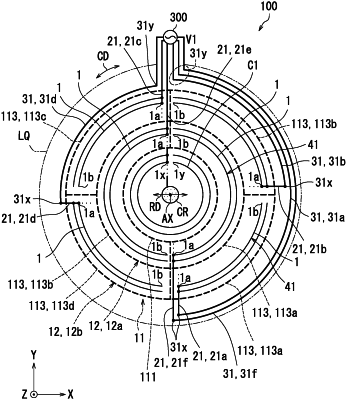| CPC G02F 1/294 (2021.01) [G02B 3/14 (2013.01)] | 19 Claims |

|
1. A liquid crystal element comprising:
a liquid crystal layer;
a plurality of first arcuate electrodes disposed concentrically about an optical axis of the liquid crystal element and configured to apply first voltage to the liquid crystal layer; and
a plurality of second arcuate electrodes disposed concentrically about the optical axis and configured to apply second voltage to the liquid crystal layer, wherein
the liquid crystal element has an electrode placement area in which the first arcuate electrodes and the second arcuate electrodes are disposed,
each of unit electrodes is constituted by one of the first arcuate electrodes and one of the second arcuate electrodes adjacent to each other in a radial direction to the optical axis, the unit electrodes being arranged side by side in the radial direction in the electrode placement area,
the liquid crystal element further comprises high-resistance layers each having a higher electrical resistivity than the first arcuate electrodes and the second arcuate electrodes, the high-resistance layers each being disposed between a corresponding one of the first arcuate electrodes and a corresponding one of the second arcuate electrodes in a plan view,
the liquid crystal element further comprises a core electrode and a center electrode, the core electrode being disposed in a part, of the electrode placement area, through which the optical axis passes, the center electrode forming a potential gradient between the center electrode and the core electrode in the electrode placement area,
a unit electrode of the unit electrodes that is located outside of a specific location in the radial direction has a radius Rn smaller than a radius Un expressed by formula (1) and formula (2), where a subscript n indicates an n-th location from the optical axis, and
the formula (2) includes a radius Sc of the center electrode:
 |